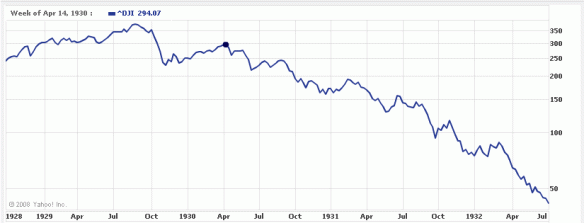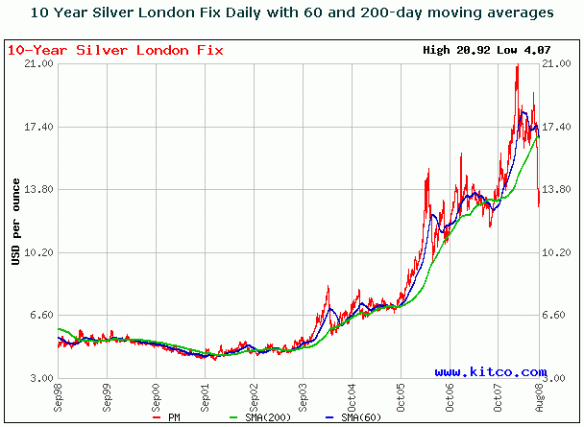I usually am not so sure about things, but the markets are looking very stretched at the moment. Sentiment among bears is of capitulation. Everywhere I go on the blogosphere, I see posts and comments about how the market is rigged by Goldman or repo desks or the PPT, and that trading against robots is a no-win situation. I hear that fundamentals don’t matter, that the bulls are in control, that the transports have confirmed the industrials, that China will drive copper the moon and still buy it all, yada, yada, yada. The upshot is that traders seem to think that the bears will be totally crushed no matter what.
Well, what exactly have the bears experienced during the 50% rally from March 6 to today? I’d say that is about as severe a drubbing as you can take in the market, the polar opposite of what the bulls got last autumn and winter. It is time for a reversal, and not a small one. This is Spring 1930 all over again:

Above chart of the Dow Industrials from Yahoo!
–
Everybody has seen these before, but here are a few quotes from that post-crash reprieve:
December 28, 1929
“Maintenance of a general high level of business in the United States during December was reviewed today by Robert P. Lamont, Secretary of Commerce, as an indication that American industry had reached a point where a break in New York stock prices does not necessarily mean a national depression.” — Associated Press dispatch.
January 1, 1930
RESERVE BANK AREAS FORECAST NEW YEAR
Despite the obvious slackening of the pace of business at the close of the year, leaders in banking and industry throughout the country maintain an optimistic attitude toward the prospects for 1930.
January 13, 1930
“Reports to the Department of Commerce indicate that business is in a satisfactory condition, Secretary Lamont said today.” – News item.
January 21, 1930
“Definite signs that business and industry have turned the corner from the temporary period of emergency that followed deflation of the speculative market were seen today by President Hoover. The President said the reports to the Cabinet showed the tide of employment had changed in the right direction.” – News dispatch from Washington.
January 24, 1930
“Trade recovery now complete President told. Business survey conference reports industry has progressed by own power. No Stimulants Needed! Progress in all lines by the early spring forecast.” – New York Herald Tribune.
March 8, 1930
“President Hoover predicted today that the worst effect of the crash upon unemployment will have been passed during the next sixty days.” – Washington Dispatch.
May 1, 1930
“While the crash only took place six months ago, I am convinced we have now passed the worst and with continued unity of effort we shall rapidly recover. There is one certainty of the future of a people of the resources, intelligence and character of the people of the United States – that is, prosperity.” – President Hoover
June 29, 1930
“The worst is over without a doubt.” – James J. Davis, Secretary of Labor.
July 6, 1930
‘BUSINESS CYCLE’ SEEN AT NEW PHASE; Bankers Hold Downward Trend in Markets Indicates Recovery Is Near. DENY ANALOGY TO 1920-21 Economists Point to Superior Credit Conditions Now, Holding Easy Money Points to Revival.
August 29, 1930
“American labor may now look to the future with confidence.” – James J. Davis, Secretary of Labor.
September 12, 1930
“We have hit bottom and are on the upswing.” – James J. Davis, Secretary of Labor.
–
The bears were down but not out in June, and quite a few armchair traders jumped in to have another go at the fast money they found when they jumped on board the sell train in October and February. Well, 100 points in about 12 trading days left them flabbergasted, and toasted more than a couple of levered accounts. When traders are flabbergasted, they tend blame manipulation, and concluding the game is rigged, all but the gamblers bow out.
Well, this trader is not flummoxed. I’ll freely admit traded this rally poorly by thinking I should only buy at 620 and then not jumping aboard when we took off on huge breadth and volume from 666, and then by shorting high-flying junk and starting to buy my long term puts too soon, but I can chalk those up as trading school tuition fees. Nothing that has happened this year should surprise anyone these days, when it is so easy to look at 80 years of daily Dow closes on Yahoo. If this is 1988 and not 1930 I will eat the Tom McKans my wife hates so much and take up a respectable profession like welding.
Speaking of 1987 and expectations for a depression, Trader, the cult documentary on Paul Tudor Jones, is finally up on Youtube. People were recently paying $1000 bucks for this thing on VHS. I can’t say that it is worth that kind of dough, but it is definitely worth an hour of your time to watch one of the contemporary greats in his element as he trades what he thinks is the analogue of 1928-29.
UPDATE: Trader is gone. The producer had it taken down. But, it is still out there if you know where to look… a certain renegade financial site has posted a link. I’ll leave it up to readers to figure out which.





